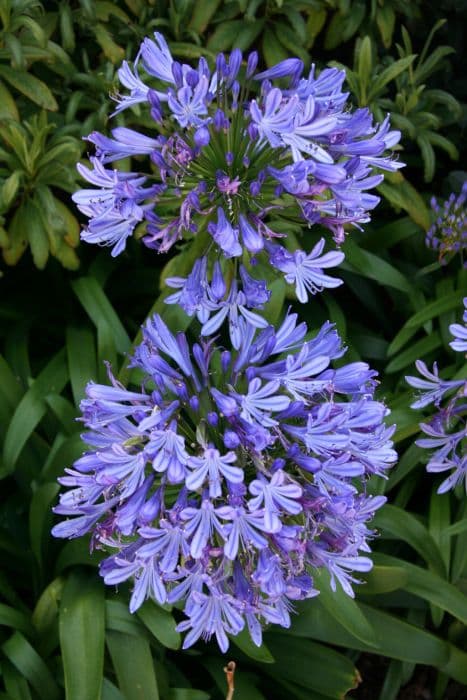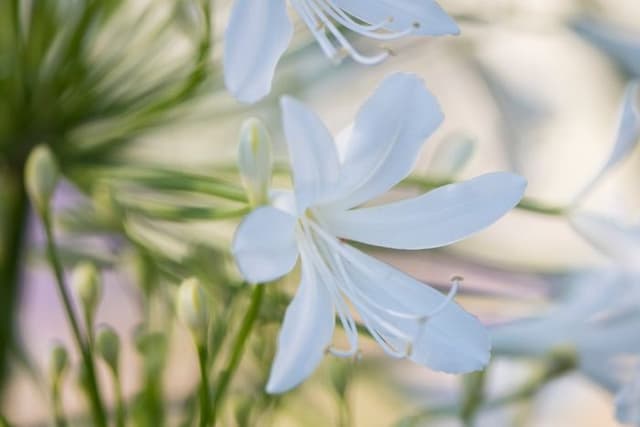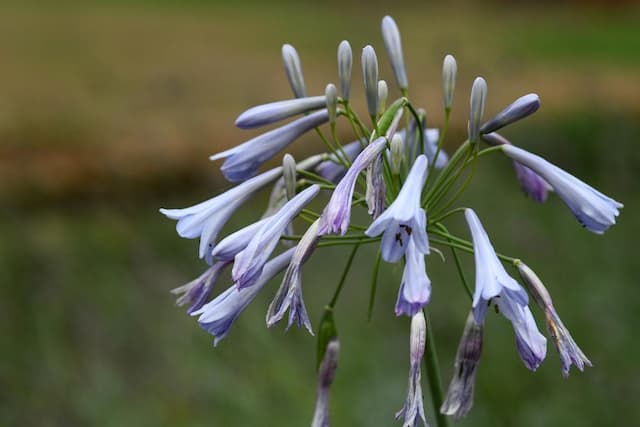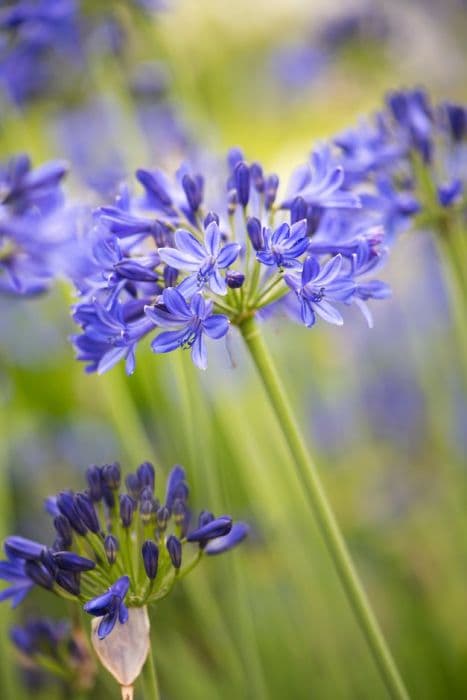African Lily Agapanthus 'Eggesford Sky'

ABOUT
The Agapanthus 'Eggesford Sky', commonly known as the Lily of the Nile, is an ornamental plant with striking features. It is characterized by its beautiful, globular clusters of flowers that sit atop long, sturdy stalks. These blossoms are a vivid sky blue color, which can add a cool and refreshing hue to any garden space. The individual flowers within the clusters are trumpet-shaped, which gives the flower heads a lush and full appearance. The foliage of the Lily of the Nile is also quite attractive, with long, strap-like leaves that form a dense and arching cluster. These leaves are a deep green color and have a glossy surface, which can catch the light and add a vibrant backdrop to the stunning blooms. The contrast between the bright blue flowers and the green leaves can make the 'Eggesford Sky' a focal point in a garden setting. Overall, the plant exudes a tropical charm and can be a dramatic and elegant addition to garden borders, beds, or as a container specimen. It is admired for the cool-toned blossoms and the lush foliage that together create a visually appealing display.
About this plant
 Names
NamesFamily
Amaryllidaceae
Synonyms
African Lily, Lily of the Nile, Love Flower
Common names
Agapanthus 'Eggesford Sky'.
 Toxicity
ToxicityTo humans
African Lily, which is the common name for Agapanthus 'Eggesford Sky', is known to be mildly toxic when ingested. This plant contains compounds that can cause gastrointestinal distress, such as nausea, vomiting, and diarrhea. It also contains small amounts of toxic alkaloids that can lead to more serious symptoms if ingested in large quantities. Contact with the sap can also cause skin irritation or allergic reactions in some individuals. Keeping parts of the plant out of reach of children and avoiding ingestion is recommended to prevent any unwanted symptoms.
To pets
The African Lily is also toxic to pets, such as dogs and cats. If an animal consumes parts of the plant, symptoms of toxicity can appear. These often include nausea, vomiting, diarrhea, and general malaise. In rarer cases, more severe symptoms such as tremors or cardiac problems could occur with significant ingestion. Pet owners should ensure their animals do not have access to this plant, and should seek veterinary care if their pet has ingested any part of it.
 Characteristics
CharacteristicsLife cycle
Perennials
Foliage type
Evergreen
Color of leaves
Green
Flower color
Blue
Height
3 feet (0.91 meters)
Spread
2 feet (0.61 meters)
Plant type
Bulb
Hardiness zones
8
Native area
South Africa
Benefits
 General Benefits
General Benefits- Attractive blossoms: Agapanthus 'Eggesford Sky', commonly known as African Lily, produces eye-catching blue flowers that add a splash of color to gardens and landscapes.
- Drought tolerance: Once established, the African Lily is quite drought-resistant, making it suitable for xeriscaping and low-water gardens.
- Low maintenance: It requires minimal care beyond basic watering and occasional feeding, ideal for gardeners who prefer low maintenance plants.
- Long flowering period: The African Lily has a long blooming season, often from early to late summer, providing extended visual interest in the garden.
- Attracts pollinators: The flowers attract bees, butterflies, and other pollinating insects, supporting local biodiversity.
- Architectural interest: With its tall flower stalks and strap-like leaves, the African Lily adds structure and texture to garden beds and borders.
- Container gardening: It is suitable for pot culture, allowing those with limited space or no garden to enjoy its beauty on patios or balconies.
- Cut flowers: The long stems and striking blooms make excellent cut flowers for arrangements and bouquets.
- Deer resistance: African Lily is generally resistant to deer, making it a good choice for gardens in areas where deer browsing is a problem.
- Tolerance of coastal conditions: It can tolerate salt-laden winds, making it suitable for gardens in coastal areas.
 Medical Properties
Medical PropertiesThis plant is not used for medical purposes.
 Air-purifying Qualities
Air-purifying QualitiesThis plant is not specifically known for air purifying qualities.
 Other Uses
Other Uses- Photography Prop: Agapanthus adds an attractive azure blue hue to the background or foreground of garden and plant photography scenes.
- Eco-friendly Ink Source: The blue sap from the flowers can potentially be used to create natural and eco-friendly inks.
- Educational Resource: The plant's distinct morphology can be used to educate students about plant structure and botany, especially in relation to monocotyledonous plants.
- Creative Arts: Agapanthus can be used in art projects, such as pressing flowers for bookmarks or incorporating into mixed media artworks.
- Garden Themes: The 'Eggesford Sky' variety can be used to create a 'blue-themed' garden landscape, attracting attention to its vibrant blooms.
- Wedding Decor: With their striking blue color, they make for exquisite wedding decorations, from centerpieces to bridal bouquet accents.
- Dye for Fabrics: Similar to the ink, the pigments from Agapanthus could be explored as a natural dye for textiles.
- Summer Festivities: Agapanthus blooms in summer and can be used as natural décor during summer garden parties or events.
- Culinary Decoration: While not typically considered edible, the flowers can be used for decorative purposes on cakes or desserts after ensuring they're pesticide-free and safe for such use.
- Bee and Butterfly Garden: Planting Agapanthus can help create a habitat for pollinators like bees and butterflies due to its attractive flowers and nectar.
Interesting Facts
 Feng Shui
Feng ShuiThe African Lily is not used in Feng Shui practice.
 Zodiac Sign Compitability
Zodiac Sign CompitabilityThe African Lily is not used in astrology practice.
 Plant Symbolism
Plant Symbolism- Love Letters: Agapanthus, often known as African Lily, is said to represent love letters. This is due to their graceful and rounded clusters of flowers, which can be reminiscent of quill and ink, tools historically used for writing correspondence.
- Secret Love: The African Lily often symbolizes a secret love or affection. Its flowers are usually hidden among the lush foliage, which can represent hidden feelings.
- Fertility and Pregnancy: Due to their robust growth and the prolific nature of the blooms, the African Lily is often associated with fertility and the beauty of pregnancy.
- Beauty: The elegant shape and striking blue hue of the African Lily represent beauty and unique charm, drawing a parallel to the allure of the natural world.
 Water
WaterThe Lily of the Nile, or Agapanthus 'Eggesford Sky', prefers consistently moist soil, so it should be watered thoroughly whenever the top inch of soil feels dry to the touch. This typically means watering once every few days, but the frequency can vary greatly depending on climate conditions and soil drainage. During hotter months or periods of drought, watering may be needed every other day, while in cooler months, once a week might suffice. Each watering session should provide enough water to soak the roots, which might be around 1-2 gallons for an established plant, depending on size and environmental conditions.
 Light
LightLily of the Nile thrives best in full sun to partial shade conditions. Ideally, it should receive at least six hours of direct sunlight a day. An optimal spot is where the morning sun can gently wake the plant, and it can be protected from the harsh afternoon sun, especially in hotter climates.
 Temperature
TemperatureLily of the Nile does best in temperatures ranging between 50°F and 90°F. The plant can handle short periods of colder weather, down to about 30°F, but frost can damage the foliage, and temperatures below 25°F can be lethal. Ideally, the plant should be kept in environments where the temperature does not drop below freezing too often.
 Pruning
PruningPrune the Lily of the Nile after blooming has finished to remove spent flower stalks and encourage further flowering. Dead leaves and damaged stems can be removed at this time as well. Pruning is typically done annually, in late fall or early winter after the flowering cycle is complete.
 Cleaning
CleaningAs needed
 Soil
SoilThe African Lily ('Eggesford Sky') thrives in a rich, well-draining soil mix; a combination of loam, compost, and sharp sand or perlite is ideal. The pH should be slightly acidic to neutral, ranging from 6.0 to 7.0 for optimal growth.
 Repotting
RepottingAfrican Lilies should be repotted every 2 to 3 years to replenish soil nutrients and to accommodate root growth. It's best to do this in the spring before the growing season begins.
 Humidity & Misting
Humidity & MistingAfrican Lilies prefer moderate humidity levels but are quite adaptable to different humidity conditions. They do not require high humidity to thrive.
 Suitable locations
Suitable locationsIndoor
Ensure bright light and well-draining soil for indoor African Lilies.
Outdoor
Plant in sun, use well-draining soil, and give space for clumps.
Hardiness zone
8-10 USDA
 Life cycle
Life cycleThe life cycle of the Agapanthus 'Eggesford Sky', commonly known as the African Lily, begins with seed germination, typically in spring or early summer, when conditions are warm and moist. Following germination, the seedling grows into a juvenile plant, developing a robust root system and foliage. African Lilies then reach maturity, establishing a clump of long, strap-like leaves and eventually producing tall flowering stalks topped with clusters of blue or blue-violet trumpet-shaped flowers typically in the summer. After the flowering period, the plant sets seed, which can be dispersed to form new plants, completing its reproductive cycle. During the colder months in temperate regions, Agapanthus 'Eggesford Sky' may enter a period of dormancy, with deciduous varieties losing their leaves until conditions are favorable again in spring. Perennial in nature, the cycle repeats annually, with the plant increasing in size and producing more flowers with each passing year.
 Propogation
PropogationPropogation time
Spring-Early Summer
The most popular method of propagation for the Lily of the Nile 'Eggesford Sky' is through division. This is typically done in the spring as new growth begins or in the fall when the plant's growth cycle has completed. When dividing, carefully lift the entire clump from the ground using a spade to minimize damage to the root system. Gently tease the roots apart, ensuring that each new division has several healthy roots and at least one or two growing points or shoots. Then, replant the divisions promptly at the same depth they were originally growing and water well to settle the soil around the roots. This propagation method not only helps to proliferate your plants but can also invigorate older clumps that have become too crowded.









